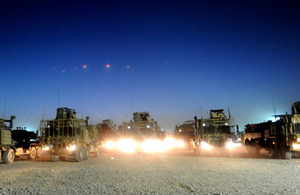IN PICTURES: Combat patrols - the biggest thing in Helmand
Getting the bullets, beans and bandages, not to mention ballistic underpants and bulldozers, from Camp Bastion to the various Forward Operating Bases of Task Force Helmand is the work of 13 Close Support Logistic Regiment (13 CSLR).

Soldiers from 13 Close Support Logistic Regiment mounting a Combat Logistic Patrol to bring equipment back from Forward Operating Base Nolay [Picture: Sergeant Rupert Frere RLC, Crown Copyright/MOD 2010]
The big supply convoys, known as Combat Logistic Patrols (CLPs), are awesome undertakings. But don’t just take my word for it. This is how 13 CSLR themselves describe it in their briefings:
CLPs are one of the (if not the) largest, most complex ground manoeuvre elements to operate within the battlespace.
Quite a claim. But a fair one. When they drive out of the gates you don’t so much measure the size of the convoy by how many vehicles it has (although it can be as many as 120 - the largest exceeded 240) but by how many kilometres it stretches for - they have exceeded 18 km. Frequently the convoys have in excess of 250 soldiers in them.
See the Gallery at Related News for more pictures of these huge convoys.
Not surprisingly these rolling traffic jams are not fast-moving, and can be seen for miles, a feature which has been turned to the unit’s advantage. Lieutenant Verity Skinner explains:
We use the sides of the vehicles like huge billboards. We paste banners on them advertising the Crimestoppers phone number scheme, and things like recruitment posters for the Afghan National Police.
Of course the down side to being big and slow-moving is that it makes them vulnerable to attack. Which is why, days before convoys go out, everything is carefully planned, and that when they do go out they are self-sufficient in terms of rations, force protection, route clearance and heavy recovery vehicles in case of breakdowns.
Everything is considered, even the effect of a formidable 15-tonne MAN EPLS (Enhanced Palletised Load System) truck taking the corner off a compound:
The CLP commanding officer is issued with money so that he can make small discretionary payments to locals if one of the vehicles causes any minor damage to property when negotiating tight turns,” said Lt Skinner.
Just sorting out the logistics, the who wants how many of what and where, is challenge enough. Private Kyrie Norman says:
We get a priority load list which tells us what we have to deliver to where. That’s meant to freeze five days before the op so we can get everything ready. There’s a noticeboard of ops allowing us to roughly plan a month ahead. But in reality it’s an ever-changing picture, right up to the last minute.
As a CLP may well have as many as 30 drops to make before returning to the safety of Camp Bastion, last moment changes of priority can have a big effect.
Back in Bastion in her role as intelligence officer, Lt Skinner keeps track of the CLP while it’s doing the rounds:
Before making any trip we check our routes, talk about what we will be transiting through and assess the threats. I sometimes travel out in the EPLS to get an eyes on the ground feel for what things are like.
Much of the ground that the CLPs travel across is ‘ungoverned’ with little or no enduring ISAF presence:
We are accompanied by force protection travelling in Ridgbacks, Mastiffs and Jackals,” said Lt Skinner.
They hold the ground for us as we pass through. They set up observation posts where they can control the area for miles around while we make a drop and make our way back again.
This can mean that troops will have to maintain the observation post and live in their vehicles for up to 36 hours at a time. It may be uncomfortable, but it makes sense. The force protection commanding officer, Lieutenant Will Butcher, said:
By holding the ground it means that the Taliban won’t have been able to reseed it with IEDs, so when the CLP transits back we don’t have to reclear the routes they drive over.
The bases they deliver to need to be ready for them when they arrive:
We don’t get a welcoming party or anything,” said Private Norman.
Often we send people on ahead to get things ready for us, move any vehicles out of the way. But the battle groups are used to it, they know they have to clear spaces for us and sort out sufficient turning circles.
The duration of the whole operation can be anything from a few hours to nine or ten days. Which often means spending days in a vehicle with four or five colleagues, eating, sleeping and, yes, that as well, without leaving the safety of the cab.
Spending 20 hours at the wheel keeping blood sugar levels soaring by shovelling in handfuls of Haribo jelly sweets to keep you awake while your mate is sitting next to you emptying coffee out of his system into a plastic bottle might not suit everyone. But it seems to suit the servicemen and women of 13 CSLR:
We get to go all over the place. We see most of our operational area and interact with the locals. It’s good to be out,” said Private Norman.